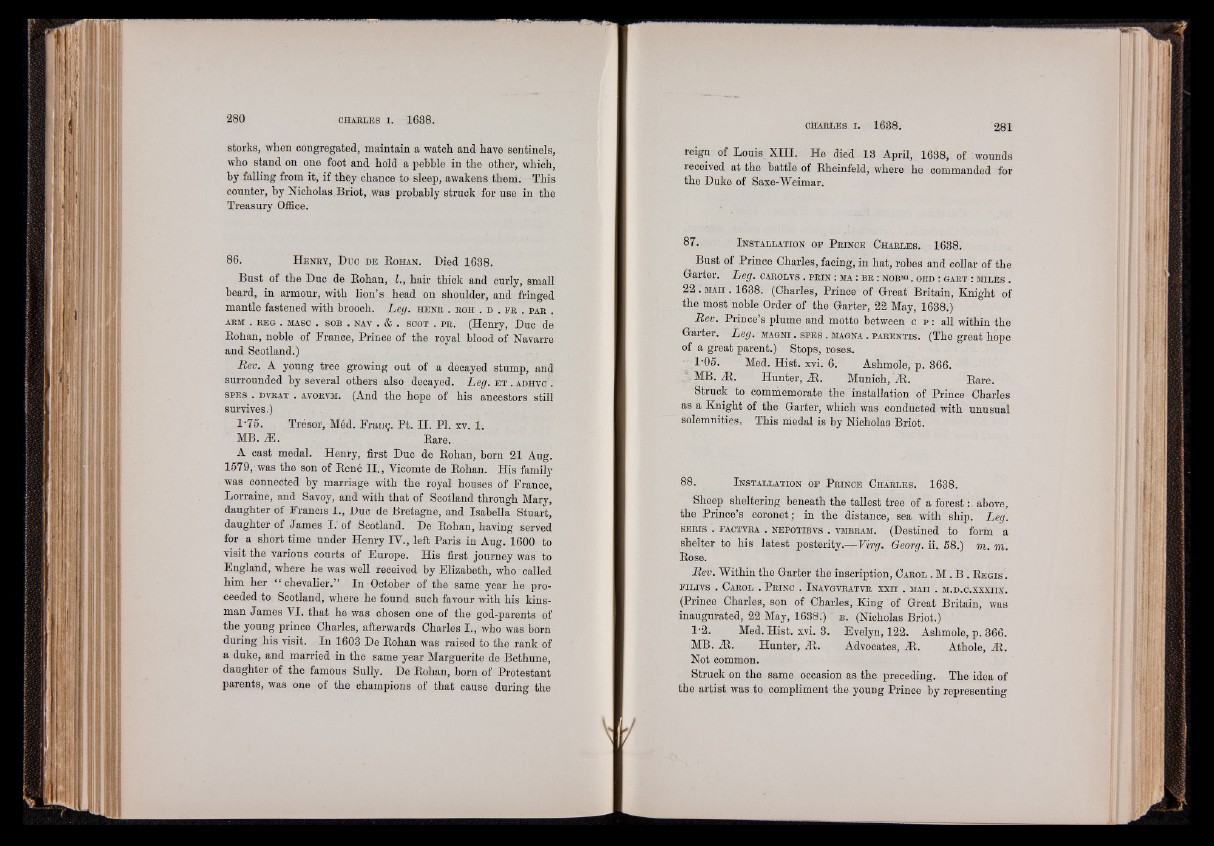
storks, when congregated, maintain a watch and have sentinels,
who stand on one foot and hold a pebble in the other, which,
by falling from it, if they chance to sleep, awakens them. This
counter, by Nicholas Briot, was probably struck for use in the
Treasury Office.
86. Henby, Duc de Bohan. Died 1688.
Bust of the Duc de Bohan, I., hair thick and curly, small
beard, in armour, with lion’s head on shoulder, and fringed
mantle fastened with brooch. Leg. h e n r . b o h . d . f e . p a b .
a bm . b e g . m a so . s o b . n a v . & . s c o t . PB. (Henry, Duc de
Bohan, noble of France, Prince of the royal blood of Navarre
and Scotland.)
Rev. A young tree growing out of a decayed stump, and
surrounded by several others also decayed. Leg. e t . a d h y G .
s p e s . DVBAT . AVOEVM. (And the hope of his ancestors still
survives.)
1’75. Trésor, Méd. Franç. Pt. II. Pl. xv. 1.
MB. Æ. Bare.
A cast medal. Henry, first Duc de Bohan, born 21 Aug.
1579,-was the son of Bené II., Vicomte de Bohan. His family
was connected by marriage with the royal houses of France,
Lorraine, and Savoy, and with that of Scotland through Mary,
daughter of Francis I., Duc de Bretagne, and Isabella Stuart,
daughter of James I. of Scotland. De Bohan, having served
for a short time under Henry IV., left Paris in Aug. 1600 to
visit the various courts of Europe. His first journey was to
England, where he was well received by Elizabeth, who called
him her “ chevalier.” In October of the same year he proceeded
to Scotland, where he found such favour with his kinsman
James VI. that he was chosen ODe of the god-parents of
the young prince Charles, afterwards Charles I., who was born
during his visit. In 1603 De Bohan was raised to the rank of
a duke, and married in the same year Marguerite de Bethune,
daughter of the famous Sully. De Bohan, born of Protestant
parents, was one of the champions of that cause during the
reign of Louis XIII. He died 13 April, 1638, of wounds
leceived at the battle of Bheinfeld, where he commanded for
the Duke of Saxe-Weimar.
87. I n s t a l l a t i o n o f P b i n c e C h a b l e s . 1638.
Bust of Prince Charles, facing, in hat, robes and collar of the
Garter. Leg. c a b o l v s . p b in : ma : b e : n o b mi . o e d : g a b t : m l l e s .
22 . m a ii . 1638. (Charles, Prince of Great Britain, Knight of
the most noble Order of the Garter, 22 May, 1638.)
Rev. Prince’s plume and motto between o p : all within the
Gaiter. Leg. m a g n i . s p e s . m a g n a . p a b e n t i s . (The great hope
of a great parent.) Stops, roses.
■ 1'05. Med. Hist. xvi. 6. Ashmole, p. 366.
,a. MB. a R . Hunter, M. Munich, a B . Bare.
Struck to commemorate the installation of Prince Charles
as a Knight of the Garter, which was conducted with unusual
solemnities. This medal is by Nicholas Briot.
88. I n s t a l l a t i o n o f P b i n c e C h a b l e s . 1638.
Sheep sheltering beneath the tallest tree of a forest: above,
the Prince’s coronet ; in the distance, sea with ship. Leg'.
SEBis . f a c t v e a . n e p o t i b v s . vmbbam. (Destined to form a
shelter to his latest posterity.—Virg. Georg, ii. 58.) m. m.
Bose.
Rev. Within the Garter the inscription, C a r o l . M . B . B e g i s
f i l i v s . C a r o l . P b i n c . I n a v g v r a t v e x x i i . maet . m .d .c .x x x h x .
(Prince Charles, son of Charles, King of Great Britain, was
inaugurated, 22 May, 1638.') b . (Nicholas Briot.)
1-2. Med. Hist. xvi. 3. Evelyn, 122. Ashmole, p. 366.
MB. At. Hunter, aB. Advocates, aB. Athole, aB.
Not common.
Struck on the same occasion as the preceding. The idea of
the artist was to compliment the young Prince by representing